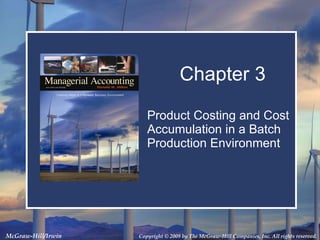Chapter03 s
- 1. Product Costing and Cost Accumulation in a Batch Production Environment Chapter 3
- 2. Learning Objective 1
- 3. Product and Service Costing 3- Financial Accounting Product costs are used to value inventory and to compute cost of goods sold. Managerial Accounting and Cost Management Product costs are used for planning, control, directing, and management decision making. Our focus changes from financial statement costs to operations
- 4. Learning Objective 2
- 5. 3- Flow of Costs in Manufacturing Firm
- 6. Learning Objective 3
- 7. 3- Process Costing Job-Order Costing Types of Product-Costing Systems Used for production of large, unique, high-cost items. Built to order rather than mass produced. Many costs can be directly traced to each job. TWO TYPES: Job-shop operations Products manufactured in very low volumes or one at a time. Batch-production operations Multiple products in batches of relatively small quantity.
- 8. 3- Job-Order Cost Accounting
- 9. Learning Objective 4
- 10. Overhead is applied to jobs using a predetermined overhead rate (POHR) based on estimates made at the beginning of the accounting period. 3- Overhead applied = POHR Ã Actual activity Based on estimates , and determined before the period begins Actual amount of the allocation base, such as direct labor hours, incurred during the period 1 2 Manufacturing Overhead Costs POHR = Budgeted manufacturing overhead cost Budgeted amount of cost driver (or activity base)
- 11. Learning Objective 5
- 12. 3- Raw Materials Material Purchases Direct Material Direct Material Mfg. Overhead Indirect Material Indirect Material Work in Process (Job-Cost Record) Job-Order System Cost Flows
- 13. 3- Direct Labor Mfg. Overhead Indirect Material Direct Material Indirect Labor Direct Labor Indirect Labor Wages Payable Work in Process (Job-Cost Record) Job-Order System Cost Flows
- 14. 3- Direct Labor Mfg. Overhead Indirect Material Direct Material Overhead Applied to Work in Process If actual and applied manufacturing overhead are not equal, a year-end adjustment is required. We will look at the procedure to accomplish this later. Indirect Labor Direct Labor Overhead Applied Indirect Labor Wages Payable Work in Process (Job-Cost Record) Job-Order System Cost Flows
- 15. 3- Cost of Goods Mfd. Finished Goods Cost of Goods Sold Cost of Goods Mfd. Cost of Goods Sold Cost of Goods Sold Direct Material Direct Labor Overhead Applied Work in Process (Job-Cost Record) Job-Order System Cost Flows
- 16. 3- Overapplied and Underapplied Manufacturing Overhead - Summary
- 17. Learning Objective 6
- 18. 3- Schedule of Cost of Goods Manufactured
- 19. 3- Schedule of Cost of Goods Sold
- 20. 3- Actual direct material and direct labor combined with actual overhead. Actual direct material and direct labor combined with predetermined overhead. Using a predetermined rate makes it possible to estimate total job costs sooner. Actual overhead for the period is not known until the end of the period. Actual and Normal Costing
- 21. Learning Objective 7
- 22. Departmental Overhead Rates 3- Department 1 Department 2 Department 3 Products Cost pools Direct Labor Hours Machine Hours Raw Materials Cost Stage One: Costs assigned to pools Stage Two: Costs applied to products Departmental Allocation Bases Indirect Materials Other Overhead Indirect Labor
- 23. Learning Objective 8
- 24. CAN BE USED IN NONMANUFACTURING ORGANIZATIONS THE JOB Cases Programs Contracts Missions CHANGING TECHNOLOGY IN MANUFACTURUNG OPERATIONS Computerized data interchange has eliminated much of the paperwork associated with job-order cost systems. Scanning devices have simplified data entry to record material and labor use. 3- Job-Order Costing
- 25. End of Chapter 3 3-
























